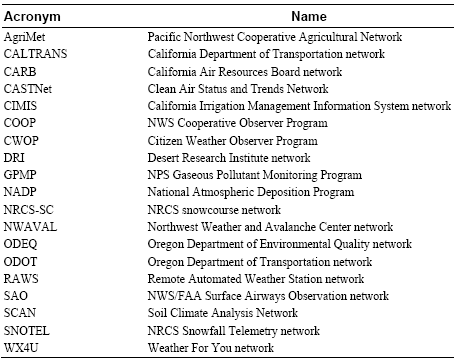Weather and Climate Inventory, Klamath Network, National Park Service, 2007
4.0. Station Inventory
4.1. Climate and Weather Networks
Most stations in the KLMN region are associated with at least one of 19 major weather/climate networks (Table 4.1). Brief descriptions of each weather/climate network are provided below (see Appendix G for greater detail).
Table 4.1. Weather/climate networks represented within the KLMN.
4.1.1. Pacific Northwest Cooperative Agricultural Network (AgriMet)
AgriMet is a network of automated weather stations operated by the U.S. Bureau of Reclamation. The stations in AgriMet are located primarily in irrigated agricultural areas throughout the Pacific Northwest.
4.1.2. California Department of Transportation (CALTRANS) Network
These weather stations are operated by the CALTRANS in support of management activities for California’s transportation network. Measured meteorological elements usually include temperature, precipitation, wind, and relative humidity.
4.1.3. California Air Resources Board (CARB) Network
Meteorological measurements are taken at CARB sites in support of their overall mission of promoting and protecting public health, welfare and ecological resources in California through the reduction of air pollutants, while accounting for economical effects of such measures. Measured elements include temperature, relative humidity, precipitation, and wind speed and direction.
4.1.4. Clean Air Status and Trends Network (CASTNet)
CASTNet is primarily an air-quality monitoring network managed by the EPA. Standard hourly weather and climate elements are measured and include temperature, wind, humidity, solar radiation, soil temperature, and sometimes moisture. These elements are intended to support interpretation of air-quality parameters that also are measured at CASTNet sites. Data records at CASTNet sites are generally one–two decades in length.
4.1.5. California Irrigation Management Information System (CIMIS) Network
The California Irrigation Management Information System (CIMIS), operated through the California Department of Water Resources, is a network of over 120 automated weather stations in the state of California. CIMIS stations are used to assist irrigators in managing their water resources efficiently. Measured meteorological elements at CIMIS stations generally include temperature, precipitation, wind, and solar radiation. Some stations measure additional parameters such as soil temperature and moisture.
4.1.6. NWS Cooperative Observer Program (COOP)
The COOP network has been a foundation of the U.S. climate program for decades and continues to play an important role. Manual measurements are made by volunteers and consist of daily maximum and minimum temperatures, observation-time temperature, daily precipitation, daily snowfall, and snow depth. When blended with NWS measurements, the data set is known as SOD, or “Summary of the Day.” The quality of data from COOP sites ranges from excellent to modest.
4.1.7. Citizen Weather Observer Program (CWOP)
The CWOP network consists primarily of automated weather stations operated by private citizens who have either an Internet connection and/or a wireless Ham radio setup. Data from CWOP stations are specifically intended for use in research, education, and homeland security activities. Although standard meteorological elements such as temperature, precipitation, and wind are measured at all CWOP stations, station characteristics do vary, including sensor types and site exposure.
4.1.8. Desert Research Institute (DRI) Network
The Desert Research Institute (DRI) operates this network of automated weather stations, located primarily in California and Western Nevada. Many of these stations are located in remote mountain and desert locations and provide data that are often used in support of various environmental studies. Meteorology elements are measured every 10 minutes and include temperature, wind, humidity, barometric pressure, precipitation, and solar radiation.


